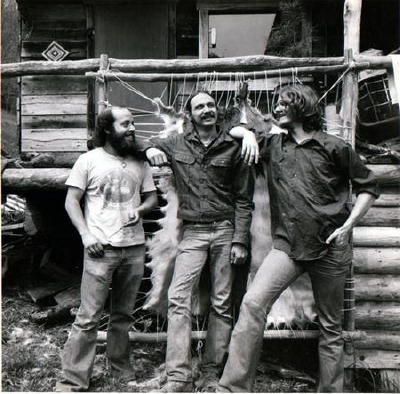
Denny Hodges stands between two hitchhikers who were
passing through in this photo at Hodges' former Calhoun
County farm, circa 1977. He later worked as a school
counselor and mental-health counselor before retiring.
Hodges, now 64, lives up a hollow in Lewis County. He will
be part of Topper Sherwood's "back-to-the-landers" film.
Former Charleston reporter works at making documentary about the 'back-to-the-landers'
By Bob Schwarz Staff Writer
www.wvgazette.com
Maybe Topper Sherwood should have known it would be a tough task when he started making a full-length documentary film about the "back-to-the-landers."
Three years later, he is trying to figure out how to finish the project.
He has run out of money, and until new money comes along, he can only pursue this as a spare-time project. He and his wife have two children. His wife works as a landscape designer, but Sherwood has to bring in money, too.
The heaviest influx of back-to-the-landers came from about 1971 through 1976, when a small but steady stream of them spread out into virtually every county.
They were mostly in their 20s, refugees from big cities who were turning their backs on office jobs and urban life and hoping to raise most of their own food. Some settled on rural ridges. Others settled up remote hollows where West Virginians hadn't lived for years.
"Whenever I tell people about this project, there's an inevitable response, you have to talk to so and so," Sherwood said. "I've talked to more than 30 so-and-sos, and what surprises me is they don't know each other â and it's because they chose a life of isolation. Some of these people don't care to go out much."
Sherwood grew up in Charleston, graduating from George Washington High and then Denison University in Ohio, where he was a literature major.
He worked as a Gazette copy editor in the early 1980s, then worked as a reporter at The Associated Press and later the Daily Mail, which he left in mid-1988.
Since then, he has worked as a free-lance writer and a grant writer, he said. Sometimes he took contractual jobs, as when he worked two years for the state Commission on the Arts. When that ended in 1995, he moved to the Eastern Panhandle, where Sherwood, 50, now lives in Martinsburg.
In 2006, he was executive director of the Arts Centre in Martinsburg. "I left there about a year ago to work on this film."
Film and video have interested him since high school, he said. The back-to-the-landers, who sometimes referred to themselves as "hippies" because that's what the locals called them, have interested him, too.
"I'm now at the stage where I've talked to a lot of people, and I'm juggling a lot of video footage," Sherwood said. "It's difficult to see the movement. I'm identifying elements of a movement whose members have rarely seen themselves as a movement. They didn't institutionalize. More often than not, their greatest successes were as individual entrepreneurs, or as employees."
Sherwood lacked funding when he began the project. "I did it on speculation. I got into a car and went and found people." He has since received $10,000 from the West Virginia Council for the Humanities and some support from Mountain Made, the Thomas-based retailer of West Virginia crafts.
He has shot nearly 50 hours of video, including some of local people who recalled these eager, but naive young newcomers who sought out those who had skills and offered friendship. "I was looking for those who were parent figures." Sherwood said.
Sherwood has done a three-minute trailer, "Appalachian Bohemes,"
that can be viewed at www.backtothelandproject.com
Courtesy of www.wvgazette.com | 


